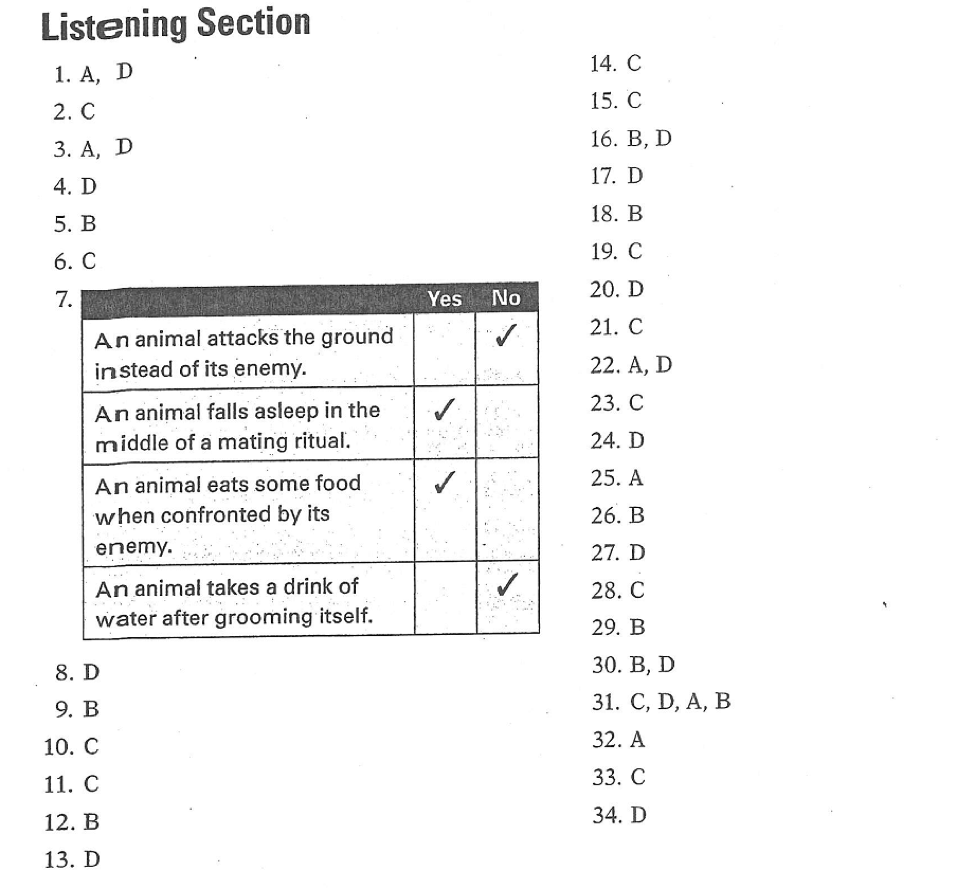TOEFL IBT Listening Practice Test 27 from Official TOEFL iBT Test with Audio Volume 1 Solution

——————————————————————————-
TOEFL IBT Listening Practice Test 27 from Official TOEFL iBT Test with Audio Volume 1 Solution Transcripts
TASK II: GAP-FILLING
TRACK 1 TRANSCRIPT
Narrator
Listen to a conversation between a student and a librarian.
Librarian
Can I help you?
Student
Yeah, I need to find a review. It’s for my English class. We have to find reviews of the play we’re reading. But they have to be from when the play was first performed – so I need to know when that was… and I suppose I should start with newspaper reviews…
Librarian
Contemporary reviews.
Student
Sorry?
Librarian
You want contemporary reviews. What’s the name of the play?
Student
It’s Happy Strangers. It was written In ,962 and we’re supposed to write about Its influence on American theater-show why It’s been so important.
Librarian
Well, that certainly explains why your professor wants you to read some of those old reviews. The critics really tore the play to pieces when it opened. It was just so controversial—nobody’d ever seen anything like it on the stage.
Student
Really? It was that big a deal?
Librarian
Oh sure. Of course, the critics’ reaction made some people kinda curious about it; they wanted to see what was causing all the fuss. In fact, we were on vacation in New York – I had to be, oh around sixteen or so—and my parents took me to see it. That would’ve been about 1965.
Student
So that was the year it premiered? Great! But… newspapers from back then aren’t online, so how do I…
Librarian
Well, we have copies of old newspapers in the basement, and all the major papers publish reference guides to their articles, reviews, etc. You’ll find them in the reference stacks in back. But I’d start with 1964. I think the play’d been running for a little while when I saw it.
Student
Oh, how’d you like it? I mean it’s just two characters onstage hanging around and basically doing nothing.
Librarian
Well, I was impressed: the actors were famous and, besides, it was my first time in a real theater. But you’re right—it was definitely different from any plays that we’d read in high school. Of course, in a small town, the assignments are pretty traditional.
Student
I’ve only read it, but it doesn’t seem like it’d be much fun to watch. The story doesn’t progress in a, in any sort of logical manner. It doesn’t have any real ending either. It just stops. Honestly, y’know, I thought it was kinda slow and boring.
Librarian
Well, I guess you might think that, but when I saw it back then it was anything but boring! Some parts were really funny—but I remember crying, too. But I m not sure just reading it… You know, they’ve done this play at least once on campus. I’m sure there’s a tape of the play in our video library. You might want to borrow it.
Student
That’s a good idea. I’ll have a better idea of what I really think of it—before I read those reviews.
Librarian
I’m sure you’ll be surprised that anyone ever found it radical—but you’ll see why it’s still powerful—dramatically speaking.
Student
Well, there must be something about it or the professor wouldn’t have assigned it. I’m sure I’ll figure it out.
——————————————————————————-
TRACK 3 TRANSCRIPT
Narrator
Listen to part of a lecture in a biology class. The class is discussing animal behavior.
Professor ..
OK, the next kind of animal behavior 1 want to talk about might be familiar to you.
You may have seen, for example, a bird that’s in the middle of a mating ritual. And, and suddenly it stops and preens—you know, it takes a few moments to straighten its feathers—and then returns to the mating ritual. This kind of behavior—this doing something that seems completely out of place—is what we call a displacement activity.
Displacement activities are activities that animals engage in when they have conflicting drives—if, if we take our example from a minute ago—if the bird is afraid of its mate, it’s conflicted, it wants to mate, but it’s also afraid and wants to run away, so instead it starts grooming itself. So the displacement activity, the, the grooming, the straightening of its feathers seems to be an irrelevant behavior.
So what do you think another example of a displacement activity might be?
Male student
How about an animal that, urn, instead of fighting its enemy or running awav it attacks a plant or a bush?
Professor
That’s a really good suggestion, Carl, but that’s called redirecting. The animal is redirecting its behavior to another object, in this case, the plant or the bush. But that’s not an irrelevant or inappropriate behavior—the behavior makes sense—it’s appropriate under the circumstances, but what doesn’t make sense is the object the behavior’s directed towards. OK, who else? Carol?
Female student
I think I read in another class about an experiment, um, where an object that the animal was afraid of was put next to its food-next to the animal’s food—and the animal it was conflicted between confronting the object, and eating the food, so instead it just fell asleep. Like that?
Professor
That’s exactly what I mean. Displacement occurs because the animal’s got two conflicting drives, two competing urges, in this case, fear and hunger—and what happens is they inhibit each other—they cancel each other out in a way, and a third, seemingly irrelevant behavior surfaces … through a process that we call disinhibition.
Now, in disinhibition, the basic idea is that two drives that seem to inhibit, to hold back a third drive, well, well, they get in the way of each other in a, in a conflict situation, and somehow lose control, lose their inhibiting effect on that third behavior… wh-which means that the third drive surfaces … it-it’s expressed in the animal’s behavior. .
Now, these displacement activities can include feeding, drinking, grooming, even sleeping. These are what we call “comfort behaviors.” So why do you think displacement activities are so often comfort behaviors, such as grooming?
Male student
Maybe because it’s easy for them to do—I mean, grooming is like one of the most accessible things an animal can do—it’s something they do all the time, and they have the-the stimulus right there, on the outside of their bodies in order to do the groom- ing—or if food is right in front of them. Basically, they don’t have to think very much about those behaviors.
Female student
Professor, isn’t it possible that animals groom because they’ve gotten messed up a little from fighting or mating? I mean, if a bird’s feathers get ruffled, or an animal’s fur – maybe it’s not so strange for them to stop and tidy themselves up at that point.
Professor
That’s another possible reason, although it doesn’t necessarily explain other behaviors such as eating, drinking, or sleeping. What’s interesting is that studies have been done that suggest that the animal’s environment may play a part in determining what kind of behavior it displays. For example, there’s a bird—the wood thrush, anyway when the wood thrush is in an attack-escape conflict—that is, it’s caught between the two urges to escape from or to attack an enemy—if it’s sitting on a horizontal branch, it’ll wipe its beak on its perch. If it’s sitting on a vertical branch, it II groom its breast feathers. The immediate environment of the bird—its immediate, um, its relationship to its immediate environment seems to play a part in which behavior it will display.

